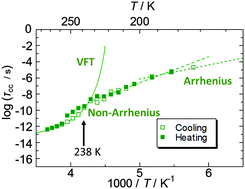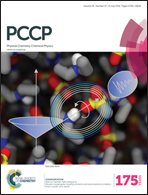An NMR study on the mechanisms of freezing and melting of water confined in spherically mesoporous silicas SBA-16†
Abstract
Thermodynamic and dynamic properties of water confined in mesoporous silica glass SBA-16 were investigated by DSC, and 1,2H NMR spectroscopy and 2H NMR spin–lattice relaxation time (T1) as a function of pore size. SBA-16 possesses the main spherical pores, interconnecting channels and micropores (corona). Water in the characteristic spherical pores of SBA-16 freezes at the homogeneous nucleation temperature of water. Between room and freezing temperatures, the correlation time of the isotropic rotation of water in the pores of SBA-16 followed the Vogel–Fulcher–Tammann (VFT) relation, which reflects the formation and growth of clusters of fragile water for changing to the strong water. The vitrification of water in micropores around 200 K was observed by 2H NMR. Above 200 K, the correlation time of the rotation of water in micropores exhibited non-Arrhenius behavior, which is correlated with the gradual decrease in the mobility of water due to the growth of hydrogen bonding, forming low density water before vitrification. After vitrification, the activation energy of the rotation of water in micropores was 25–33 kJ mol−1, which was similar to that in ice Ih for all samples. The freedom of cluster formation and water rotation increased with the increasing the pore size.


 Please wait while we load your content...
Please wait while we load your content...